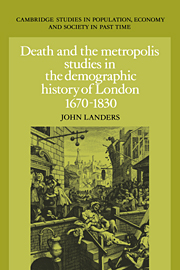Book contents
- Frontmatter
- Contents
- List of figures and maps
- List of tables
- Preface
- Acknowledgements
- Part I EIGHTEENTH-CENTURY LONDON AND ITS VITAL REGIME
- Part II THE LEVEL OF MORTALITY
- Part III DIMENSIONS OF LONDON'S EPIDEMIOLOGICAL REGIME
- Appendices
- Bibliography
- Index
- Cambridge Studies in Population Economy and Society in Past Time
Part I - EIGHTEENTH-CENTURY LONDON AND ITS VITAL REGIME
Published online by Cambridge University Press: 05 November 2011
- Frontmatter
- Contents
- List of figures and maps
- List of tables
- Preface
- Acknowledgements
- Part I EIGHTEENTH-CENTURY LONDON AND ITS VITAL REGIME
- Part II THE LEVEL OF MORTALITY
- Part III DIMENSIONS OF LONDON'S EPIDEMIOLOGICAL REGIME
- Appendices
- Bibliography
- Index
- Cambridge Studies in Population Economy and Society in Past Time
Summary
It is not enough to foster a rising tide of substantive demographic studies of demographic behavior in the past. There must also be a complementary development of organising concepts to link population characteristics to their socioeconomic context and to do justice to the mutual interaction between the two.
(Wrigley 1981a: 207)Few fields of scholarly enquiry have been so transformed by the appearance of a single work as was European historical demography by the publication of Wrigley and Schofield's English Population History in 1981. This was partly due to the sheer weight of quantitative data which the authors were able to assemble – and their success in ‘resolving the conundrum’ of eighteenth-century population growth by establishing the leading role of fertility (Wrigley 1981b) – but the book's importance was not simply that it filled an empirical gap in our knowledge of England's demographic history, however valuable such an achievement may have been in itself.
In the Population History, and related publications, the authors developed a style of explanation intended to restore population history to its proper place within historical enquiry as a whole, and to its affiliations with economic and social history which had been weakened through the discipline's lengthy preoccupation with questions of methodology and technique. As Wrigley himself pointed out, the success of such a project depended very much on the construction of an appropriate theoretical framework, and the progress of the 1980s has come about as much through conceptual developments as it has through the accumulation of empirical data.
- Type
- Chapter
- Information
- Death and the MetropolisStudies in the Demographic History of London, 1670–1830, pp. 1 - 6Publisher: Cambridge University PressPrint publication year: 1993

